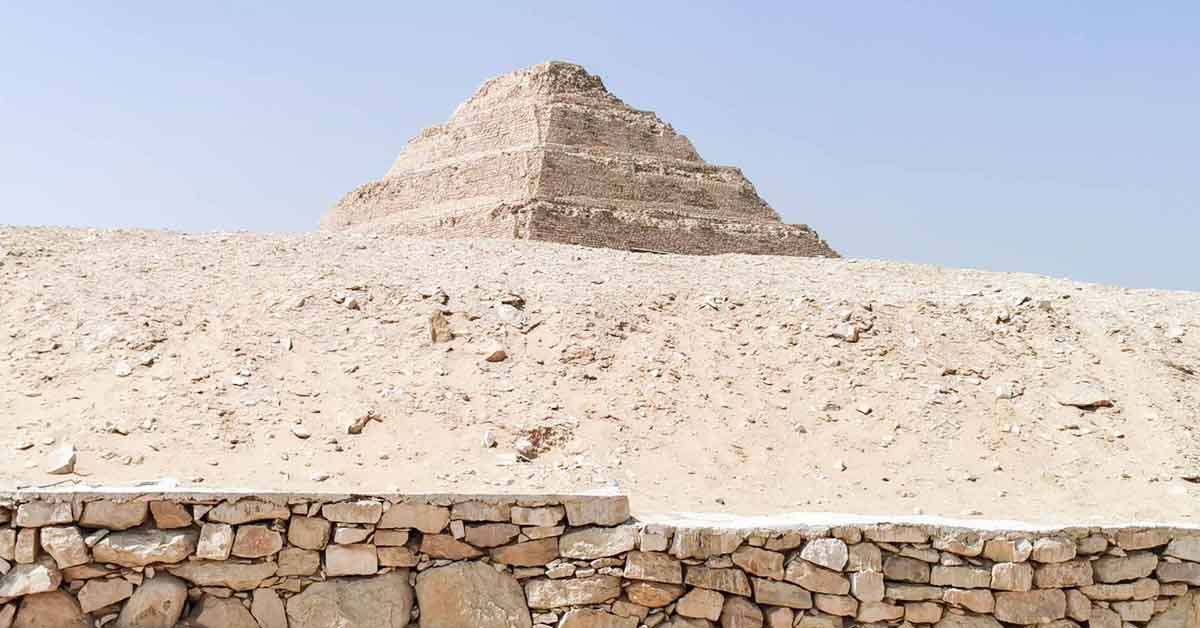Giza Pyramids vs. Teotihuacan Pyramids: Which Should You See First?
Giza Pyramids (Egypt) versus Teotihuacan Pyramids (Mexico): A side-by-side guide I put together for all those fellow curious travellers who share my passion for chasing remnants of ancient civilizations and monumental architectural wonders – and who, like me, have found themselves torn between the two most iconic pyramid destinations I could think of on Earth.
Well, I visited both of them, Egypt’s Giza Plateau, in late spring, and Teotihuacan Complex in Mexico, one early fall. In fact, I returned to Giza a couple of times, years apart, but even so, it’s hard to say which one stays as my favorite.
These are two of the world’s most iconic ancient sites known for their pyramids, – mysterious structures on two different continents, thousands of miles away from each other, both built with the stars’ alignment in mind. Still, they couldn’t be more different.
On one hand, Giza was imagined as a funerary complex, or more like a tribute to the divine power and eternal dreams of some of the proudest pharaohs Egypt had ever had. Teotihuacan, on the other hand, is said to have been a vibrant Mesoamerican ceremonial, commercial and urban center.
One was built for the dead. The other, for the living. But the question remains: which one should you visit first?
Disclosure: This article contains affiliate links. If you make a purchase after clicking one of these links, I earn a small commission from that website at no extra cost to you. Learn more: Disclosure policy.
 Travel Mood: Giza vs. Teotihuacan
Travel Mood: Giza vs. Teotihuacan
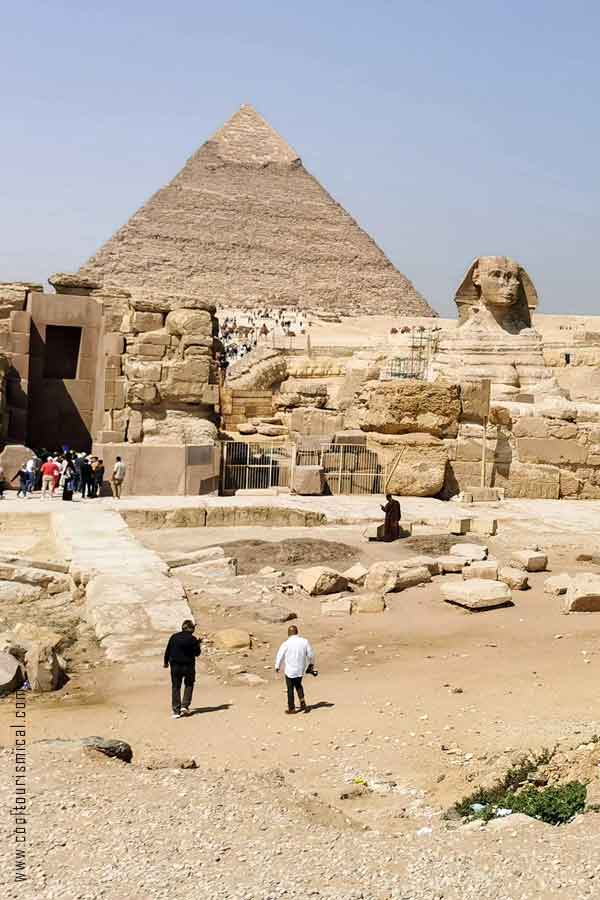
Giza Pyramids, Image Copyright © Cooltourismical.com
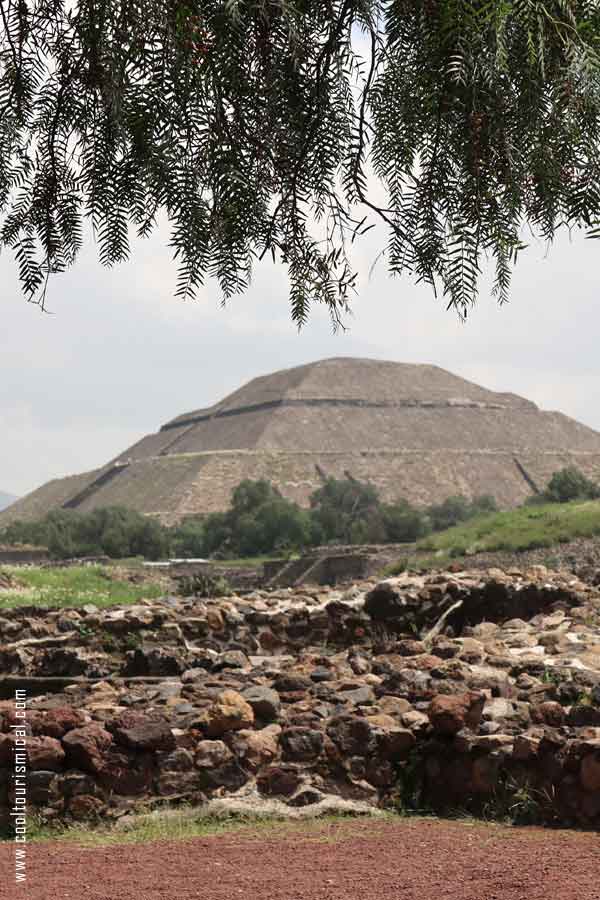
Pyramid of the Sun and the surrounding archaeological site, Image Copyright © Cooltourismical.com
At times, these magical journeys I took to see the pyramids seem like they’ve been nothing more than fleeting dreams. So, how else could I begin, if not by trying to recall them with my eyes closed, still lost in their magic?
Miles apart, from chaos to mirage and old stories, two completely different monumental archaeological sites – one raw and immediate, the other distant and dreamlike.
Or maybe it’s just how I experienced them..
Giza
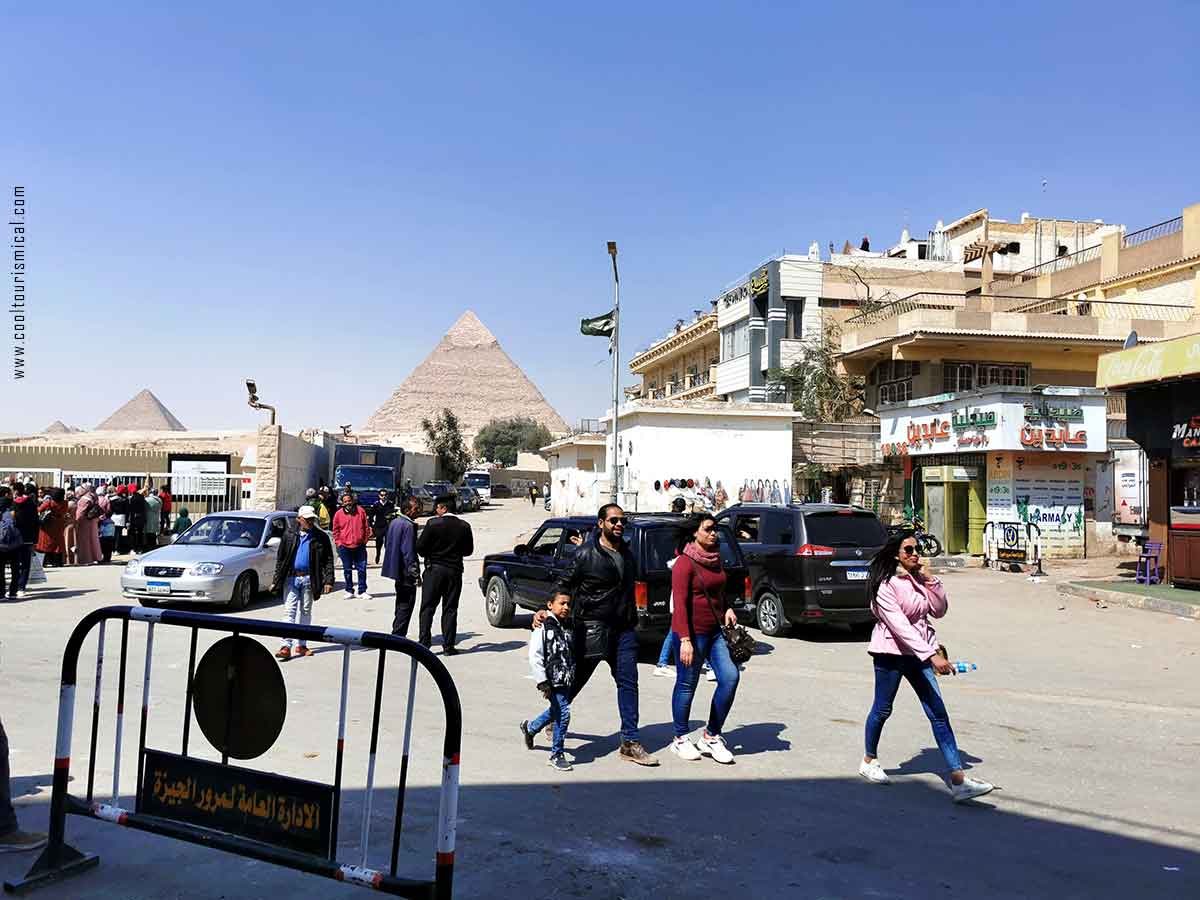
Entrance to Pyramids of Giza, Image Copyright © Cooltourismical.com
Have you ever heard of Fata Morgana? Well, that’s just how it felt seeing Giza for the first time. As we got closer to it, on the busy streets of Cairo, the necropolis seemed to rise from the desert like a vision from a forgotten myth – completely massive.
The pyramids sit on the edge of the Sahara Desert, within a vast stretch of sand, with a rocky plateau beneath your feet, and the hardly distinguishable outline of Cairo’s densely built-up urban areas creeping in.
The whole place feels pretty intense with all the golden heat flowing down the grand ancient structures. There’s very little shade wherever you look, almost no greenery — just raw desert, monumental stone, and the sun.
It has the Indiana Jones vibe and monumentality, but the atmosphere around the site is anything but quiet.
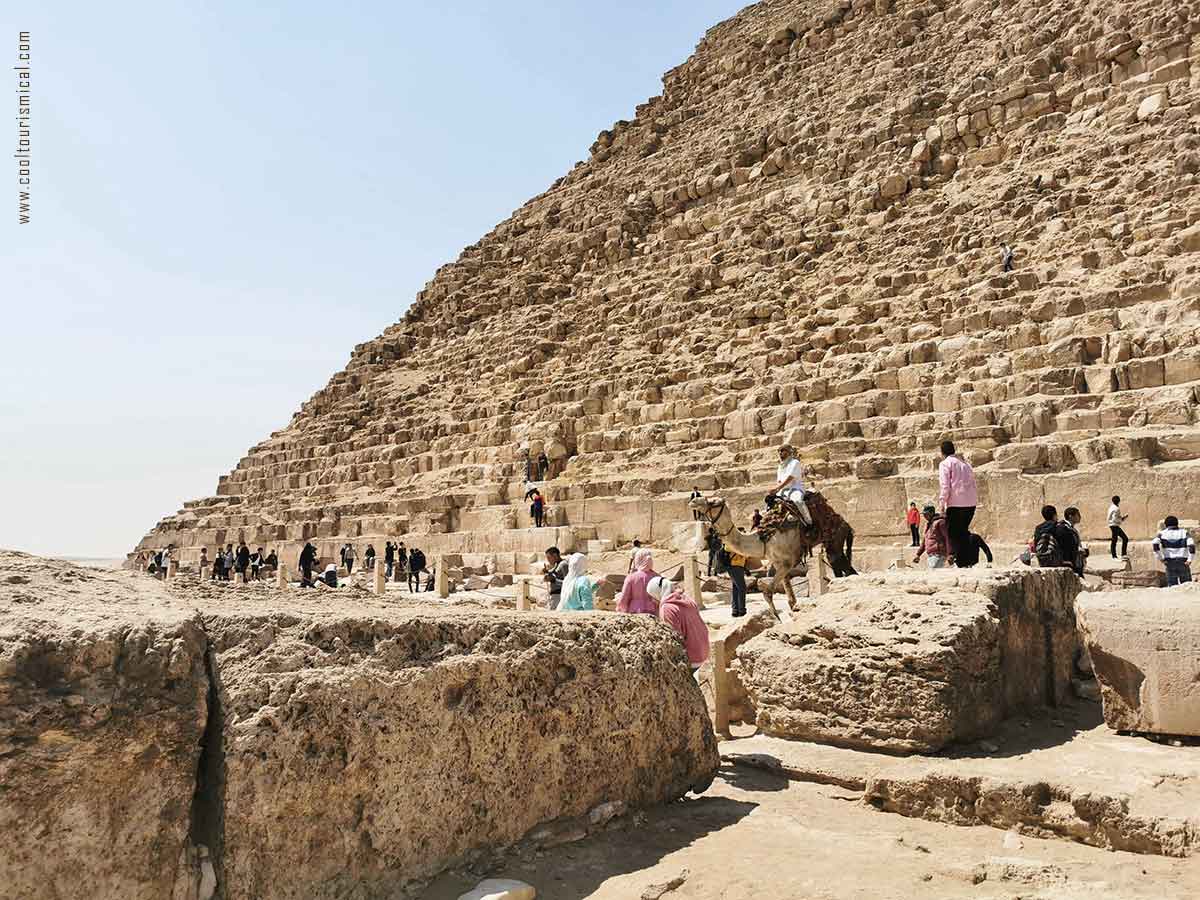
People riding camels at the base of the pyramid in Giza, Image Copyright © Cooltourismical.com
Tourist crowds gather around the pyramids and the Sphinx, guides are offering tours, and local vendors may approach you with all kinds of trinkets.
It can be chaotic, but in the end, Giza is about grandeur, legacy, almost mythic, larger-than-life energy, and sacred stillness. All of that is covering the buzz of modern tourism.
📌 Egyptians love asking tourists for photos together. For me, it felt a bit stressful at first, but honestly, it turned into a fun part of the experience.
Teotihuacan

Teotihuacan Pyramids Early in the Morning, Image Copyright © Cooltourismical.com
Compared to Giza, Teotihuacan seems like another miracle, but more laid-back, and spacious. A lost city of arts and culture.
The ruins, pyramids and palaces, are set in a highland valley, surrounded by soft hills. They sit behind tall grasses, next to shading pink pepper trees, and gigantic cacti growing here and there. I’ve seen butterflies, birds, and heard the wind in the early morning, along with the jaguar roar-like whistles.
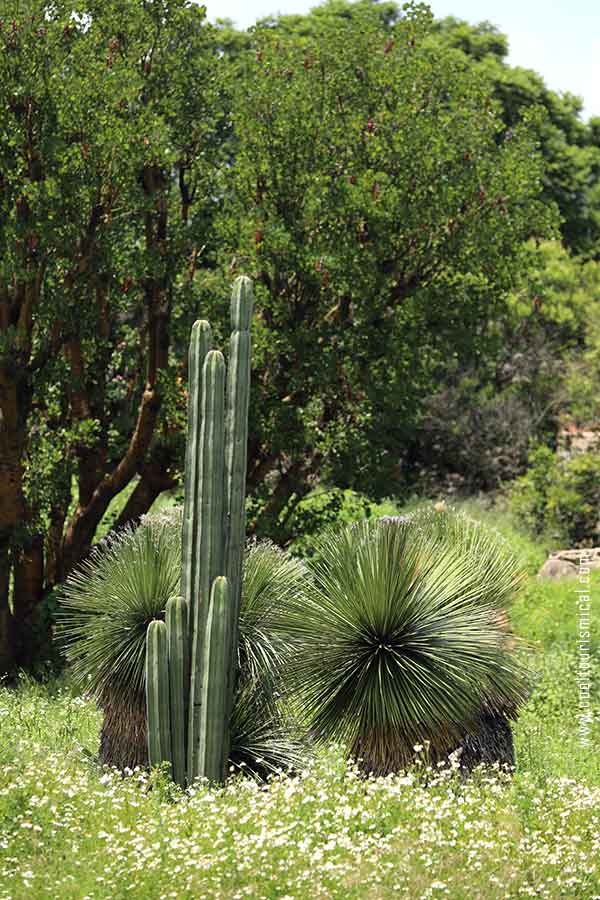
Greenery at Teotihuacan Pyramids, Image Copyright © Cooltourismical.com
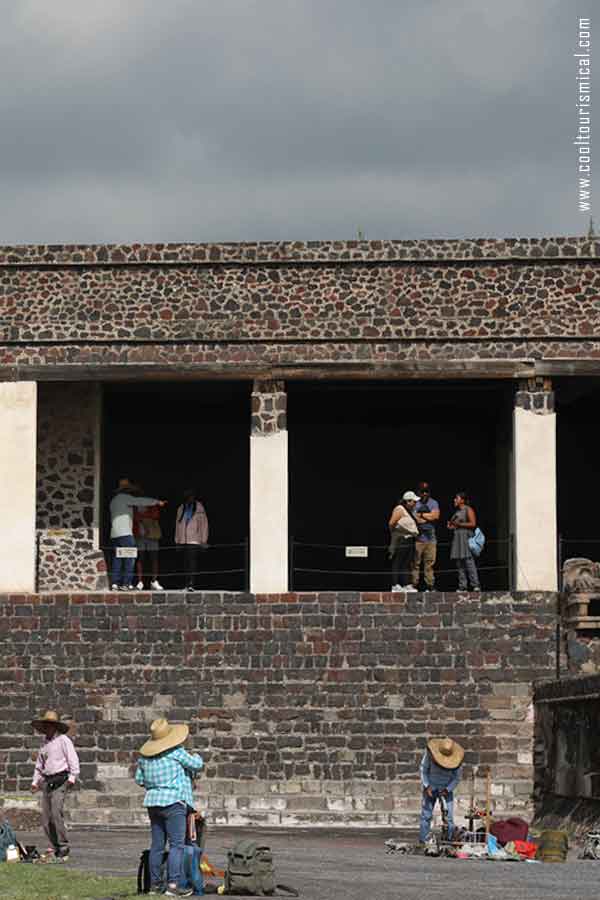
Local sellers & tourists visiting Palaces at Teotihuacan, Image Copyright © Cooltourismical.com
I think the vibe around the Teotihuacan is quieter and more meditative. Vibrant murals, serpent carvings, sacred geometry give the place a sense of ritual creativity rather than a tomb solemnity.
These pyramids feel grounded in the landscape, and there’s room to breathe and explore, literally and culturally, without being overwhelmed by crowds and noise (and constant pressure from local sellers— the most challenging part in Egypt).
Teotihuacan feels as though it has grown into the earth, like the landscape and the pyramids belong to each other.
 Giza Pyramids vs, Teotihuacan: Age & Civilization
Giza Pyramids vs, Teotihuacan: Age & Civilization
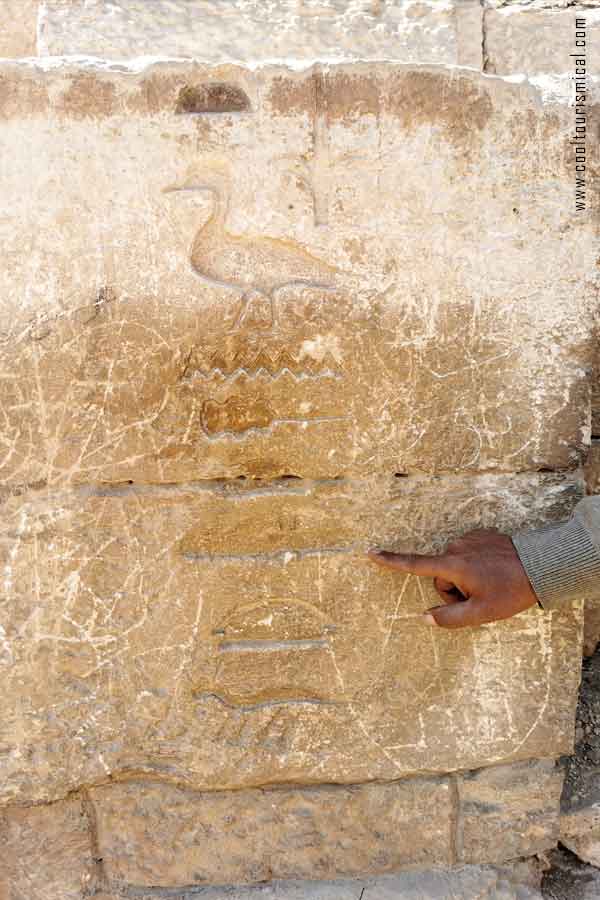
Hieroglyphs in the Eastern Cemetery at Giza Pyramids, Egypt, Image Copyright © Cooltourismical.com
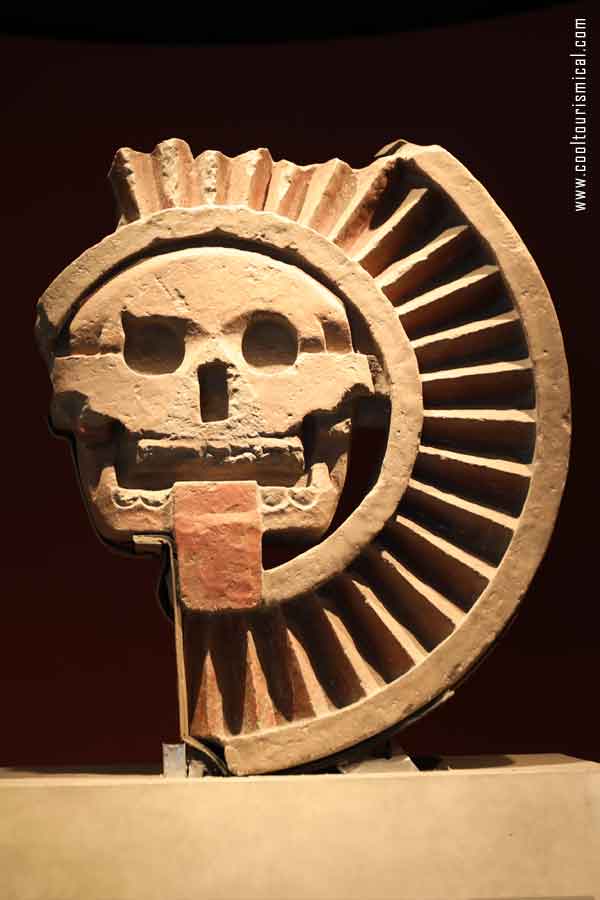
Disk of Mictlāntēcutli, the Aztec god of death and the underworld, discovered at Teotihuacan and hosted by the on-site museum, Image Copyright © Cooltourismical.com
Comparison in
🦂 Giza Pyramids – Egypt
🦅 Teotihuacan Pyramids – Mexico
Approx. Age
4,500 years old (c. 2560 BCE)
2,000 years old (c. 100 CE)
Purpose
Royal tombs
Ceremonial, plus residential
Built By
Ancient Egyptians
Unknown; rediscovered by Aztecs
Civilization
Old Kingdom of Egypt
Possibly Toltecs or pre-Aztec Mesoamericans
Giza
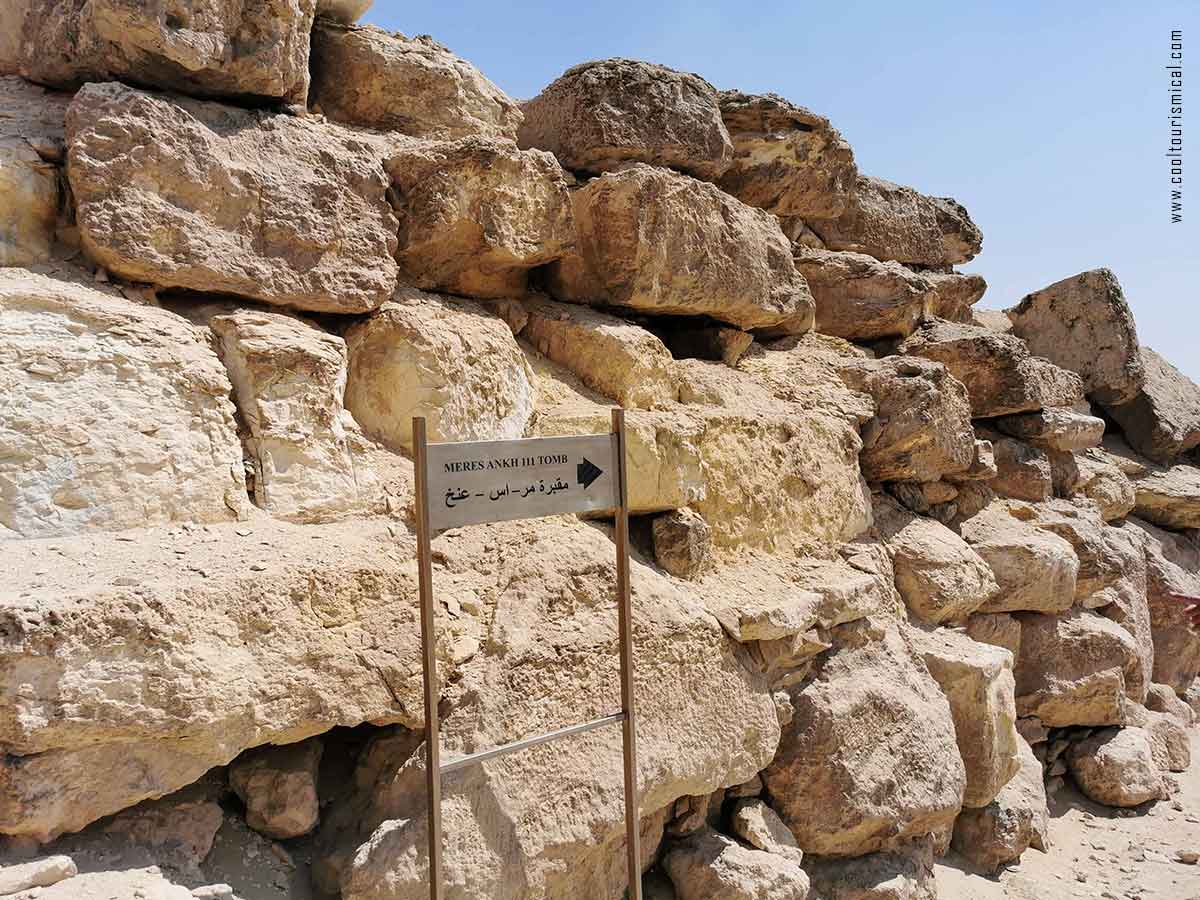
Most of the tombs in Giza are well-identified, with known owners and time periods, Image Copyright © Cooltourismical.com
As far as we know, The Giza Pyramids were constructed during Egypt’s Fourth Dynasty, sometime around 2600–2500 BCE, along with other mastabas and smaller tombs.
These absolutely massive and perfectly geometrical structures were built as royal tombs for the pharaohs Khufu, Khafre, and Menkaure. And the Great Pyramid of Khufu, in particular, is the last standing Wonder of the Ancient World.
Made of millions of limestone blocks, the pyramids aligned with the stars and were part of a larger funerary complex that included various temples above and under the ground, plus the Sphinx.
Teotihuacan

Most of the tombs in Giza are well-identified, with known owners and time periods, Copyright © Cooltourismical.com
Although half the age of the pyramids in Giza, Teotihuacan’s origins are quite a mystery. No one knows who built the three Mexican pyramids, just that they appeared between 100 BCE and 250 CE.
Some people I asked said that possibly Toltecs or pre-Aztec Mesoamericans. But clearly not the Aztecs.
And, in contrast to Giza, Teotihuacan was not primarily a vast necropolis, but one of the largest cities in America at its peak, showing a sophisticated urban planning, and symbolic alignment with celestial events. In other words, it was a center for rituals, politics, and everyday life with lots of temples and elite homes.
It seems the city was already abandoned for hundreds of years when the Aztecs discovered it, in the 14th century. They named it “Teotihuacan” — the place where gods were born.
📌 In conclusion, comparing the two pyramids sites, we could say that Giza is the heavyweight of ancient history, with direct references to famous pharaohs and hieroglyphs. Meanwhile, Teotihuacan remains an enigma, with no known builders, a fact which actually gives it a mystical, lost-city feel.
 Architecture
Architecture
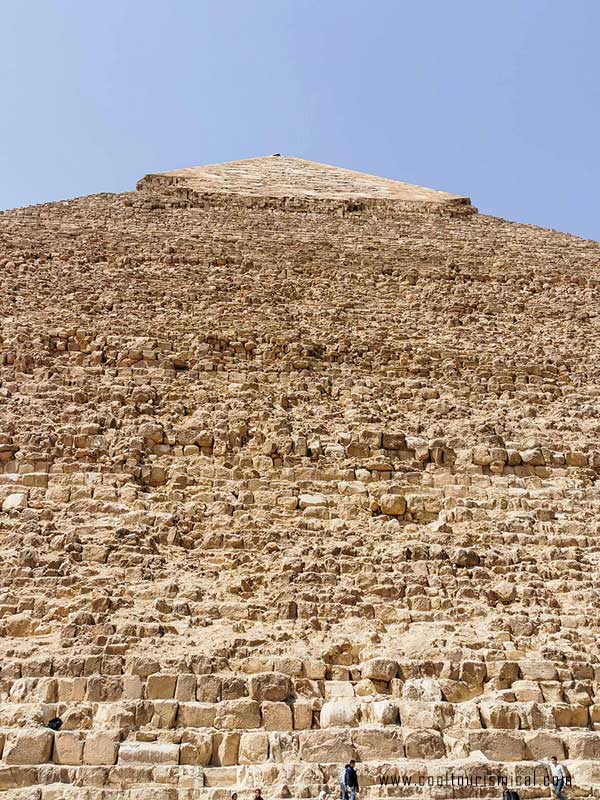
Architecture of Cheops Pyramid in Giza, Egypt, Image Copyright © Cooltourismical.com
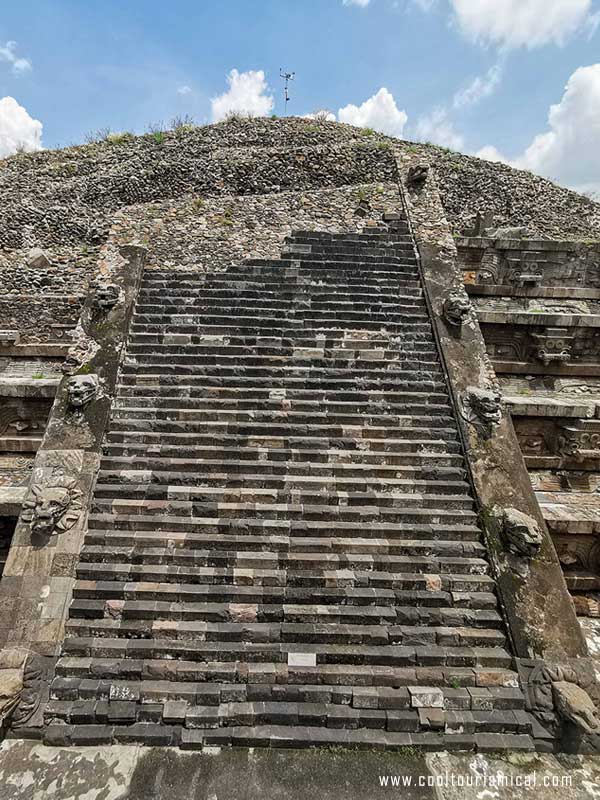
Temple of the Feathered Serpent – Teotihuacan Pyramids Architecture, Image Copyright © Cooltourismical.com
Architecture
🧭 Giza Plateau
📐 Teotihuacan Pyramids – Mexico
Architectural Style
Monumental funerary architecture, geometrical, steeply angled, evolved from earlier step pyramids.
Monumental ceremonial and civic-religious architecture, talud-tablero style. Stepped pyramids with wide platforms and slope facades, tiered, angular geometry,
Materials
Core of local limestone, with Tura limestone casing (now mostly lost); granite for inner chambers.
Made using volcanic stone, adobe and lime plaster.
Cosmic Alignment
Giza Pyramids mimic the layout of Orion’s stars. They are precisely aligned to the cardinal points (N-S-E-W); Great Pyramid’s sides deviate <0.05° from true north. Reflects order (Maat) and eternal cosmic balance.
Pyramids and Avenue of the Dead are aligned ~15.5° east of north, possibly to match sunrise on specific days or the setting of the Pleiades; The city reflects the cosmogram, a map of the universe and its renewal trough ritual.
Although they are grouped under the same cultural travel category as pyramid destinations, the Pyramids of Giza in Egypt are quite different from the ones in Teotihuacan, Mexico, in terms of architectural design, function, as well as construction materials.
Everything starts from the fact that Giza was meant to be a necropolis for eternity, while Teotihuacan functioned as a city of the living with ceremonial temples, here and there.
Giza
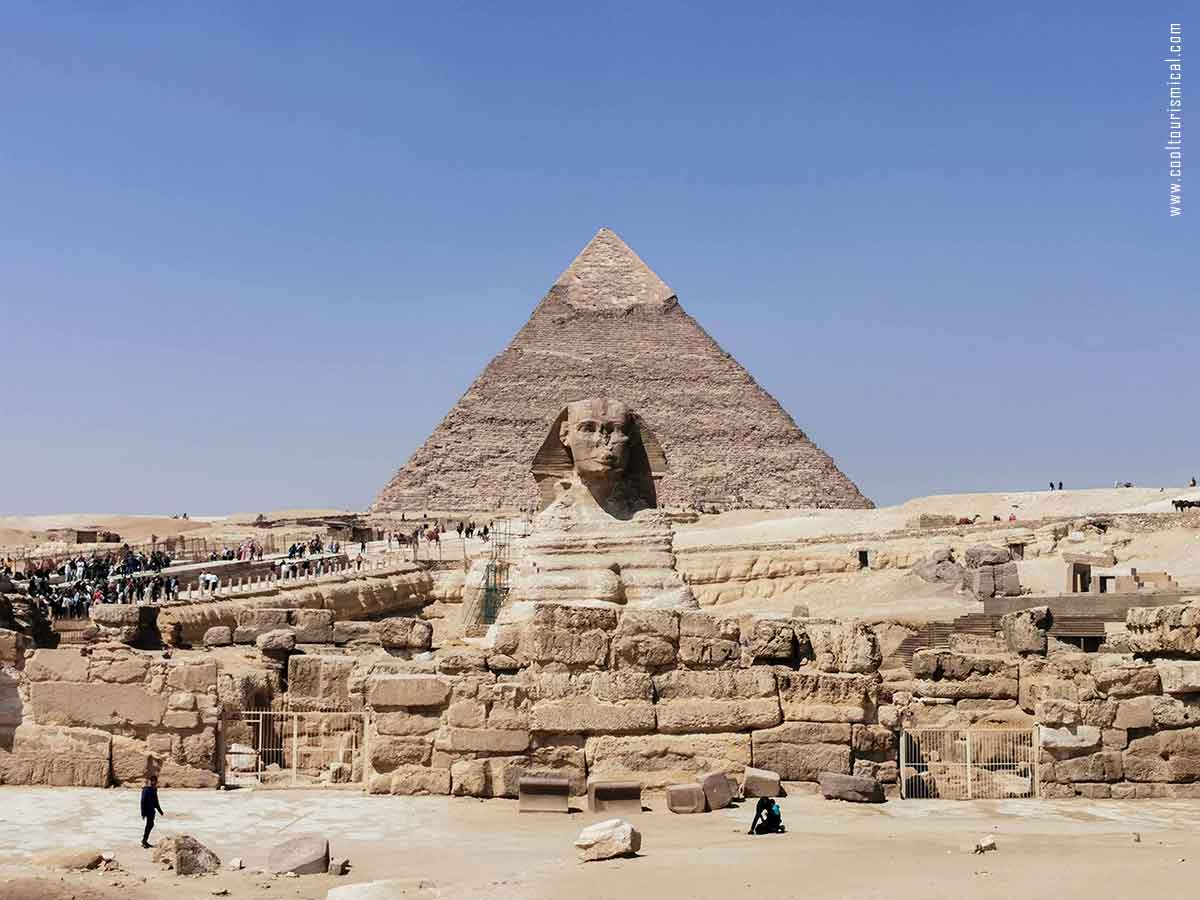
Giza Archaeological Site, Sphinx View, Egypt, Image Copyright © Cooltourismical.com
What we find in Giza is a more austere, funerary architecture, built primarily for pharaohs.
The three giant pyramids (Khufu, Khafre, and Menkaure) are tombs meant to house the soul on its journey to the afterlife.
Their architecture is monumental, eternal, and geometrically pure. And the whole construction concept aligns the complex with solar, cosmic, and religious symbolism — especially with the sun god Ra. Even the materials speak of the same sacred intent: massive blocks of granite for scale and once-polished white limestone for reflecting the sunlight.
Teotihuacan
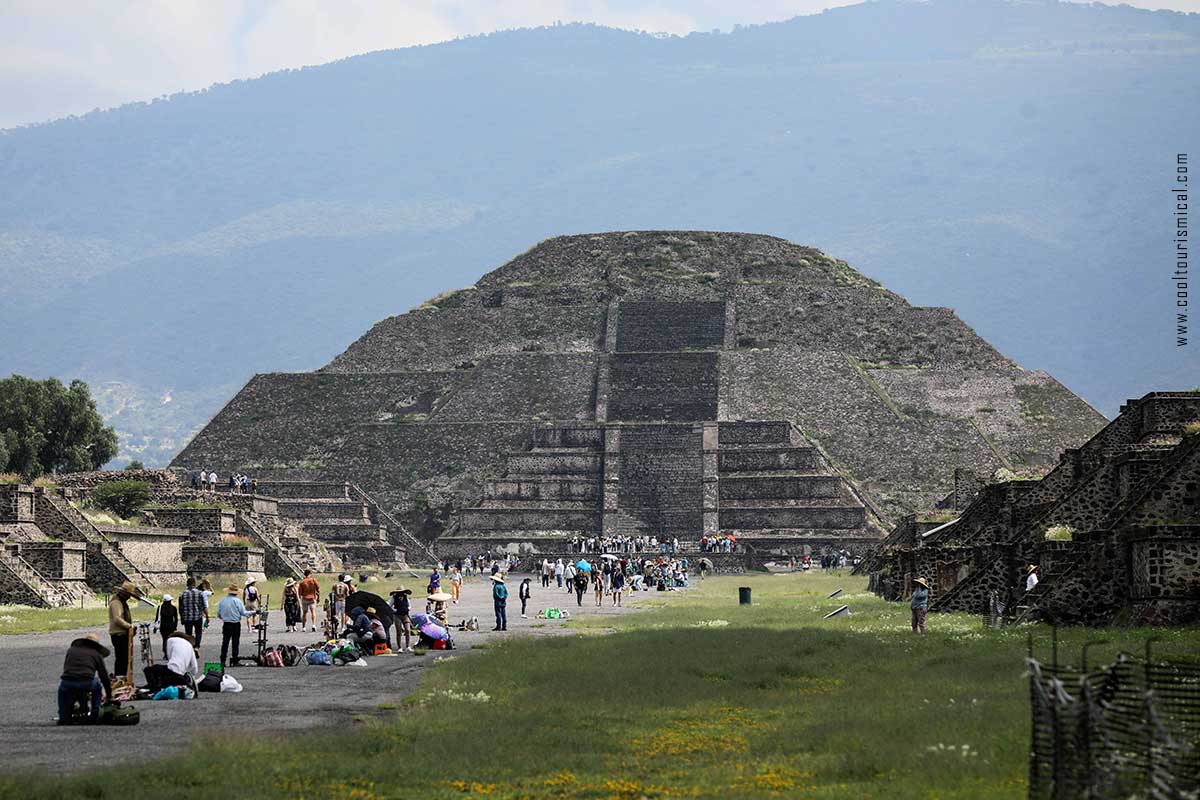
Teotihuacan Archaeological Site, Pyramid of the Moon View, Mexico, Image Copyright © Cooltourismical.com
In Teotihuacan, though, the pyramids (Sun, Moon and Feathered Serpent) look and feel differently.
This site used to be a ceremonial and urban center, for both ritual and daily life. And the Pyramids inside were likely altars or platforms for religious ceremonies, not tombs. Built in the talud-tablero style — sloped base with vertical panels — they show a stepped, trapezoidal shape typical of Mesoamerican architecture, rather than pointed peaks like in Giza.
The Pyramid of the Sun and Pyramid of the Moon both have this multi-level, terraced structure, and they were originally topped by temples — now lost.
Materials were also different: volcanic stone like tezontle, mixed with adobe and lime plaster.
The Interiors
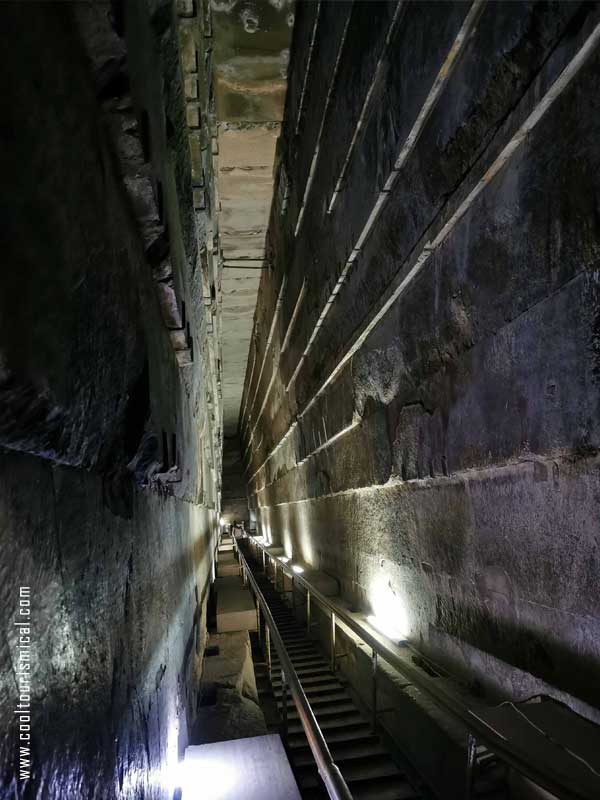
Tunnel inside The Great Pyramid of Giza, Image Copyright © Cooltourismical.com
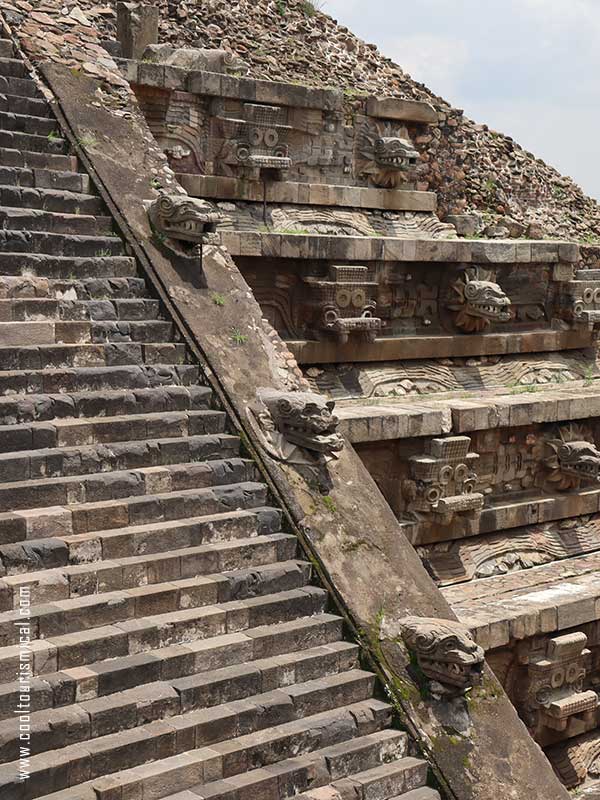
Temple of the Feathered Serpent Carvings, Image Copyright © Cooltourismical.com
Regarding the interiors, the pyramids in Giza, and additional tombs, have tunnels and chambers decorated with carvings, hieroglyphs and scenes of the afterlife.
Like everyone else, I did enter Cheops Pyramid. A bit hard to climb and suffocating at the same time. But some of the most fascinating underground chambers that I visited are definitely in the Eastern Cemetery. This was once home to large stone mastabas for Khufu’s family and top officials. This article speaks more about the cemetery.
I do recommend seeing the tomb of Qar. Although the mastaba structure above the ground has mostly vanished, the sunken chambers with hieroglyphs and life-like standing statues still exist.
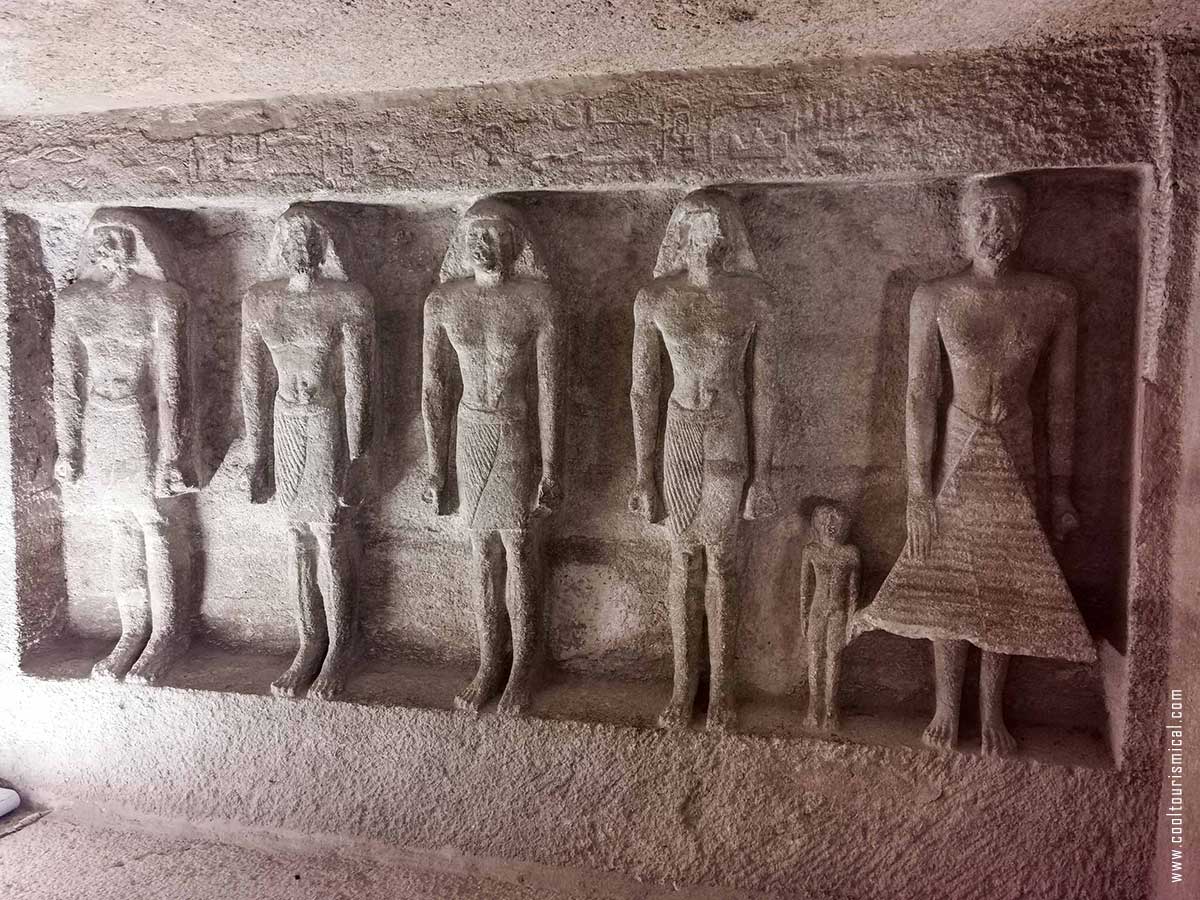
Tomb of Qar, Eastern Cemetery, Giza Necropolis, Image Copyright © Cooltourismical.com
In contrast, the pyramids in Teotihuacan are completely solid, no inner chambers, with their interiors entirely filled in.
A somewhat exception is the Temple of the Feathered Serpent (Quetzalcoatl) which was found inside La Ciudadela. In 2003, during excavations, a tunnel along with several ceremonial chambers were discovered beneath the pyramid accidentally after a heavy rain caused a sinkhole.
The temple features rows of carved stone serpent heads, seashells, and symbolic motifs representing water, fertility, and divine power. These decorative elements reflect the mythological complexity of the city and its gods, carved into the very façade of its sacred spaces.
 Layout & How to Explore
Layout & How to Explore
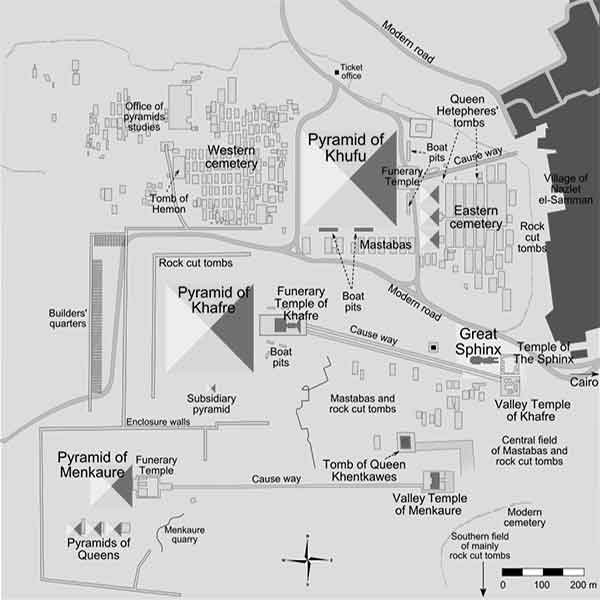
Giza Complex Map, By MesserWoland (CC BY-SA 1.0)
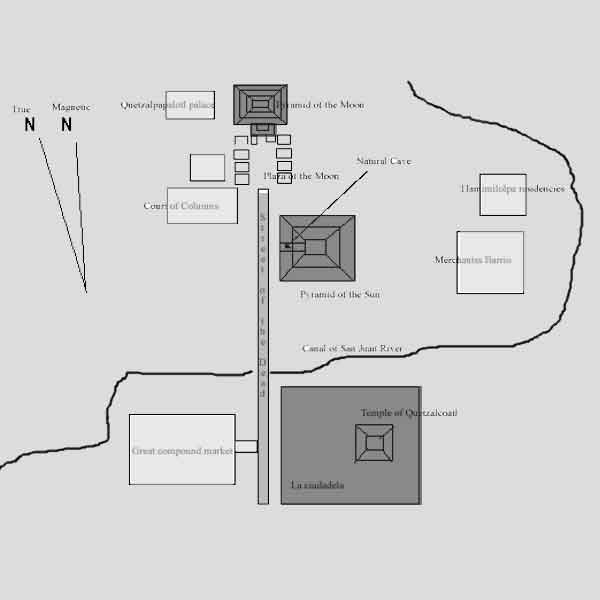
Teotihuacan Map, By Maunus (CC BY-SA 1.0)
Comparison in
🧭 Giza Plateau
📐 Teotihuacan Pyramids – Mexico
Main Pyramids
Khufu, Khafre, and Menkaure
Pyramids of the Sun, Moon, and Serpent
Notable Extras
The Sphinx and other temples
Avenue of the Dead, Palace of Quetzalpapálotl, Citadel
Climbable?
No. Only the inside of Great Pyramid of Khufu
No. Just the exterior shell of the Serpent Pyramid.
Giza
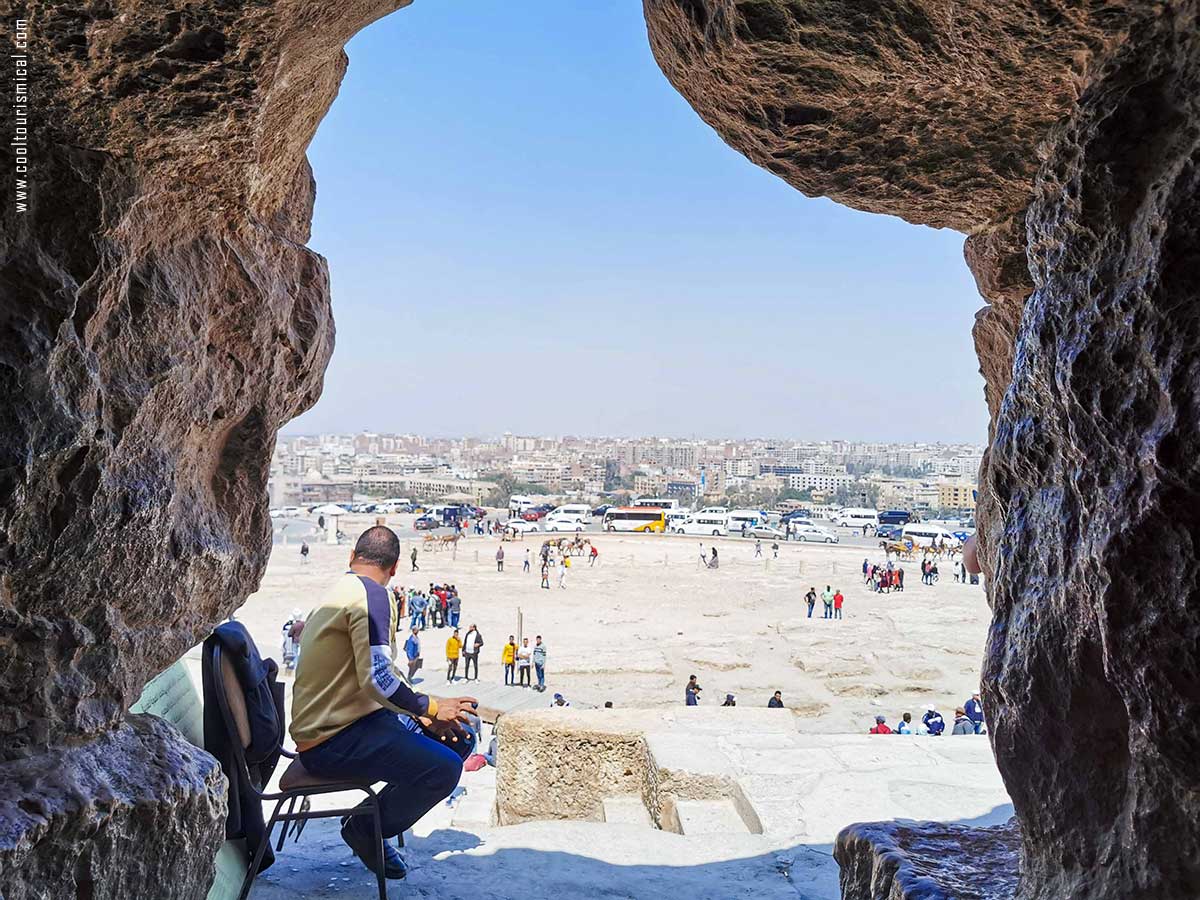
Cairo view from inside the Great Pyramid of Giza (Cheops), Image Copyright © Cooltourismical.com
The Giza Plateau is located in Egypt, on the southwestern edge of Greater Cairo, at about 13–15 km from downtown. You can easily reach it by car or taxi in about about 30–40 minutes.
While the plateau was once completely isolated in the desert, today the city has expanded almost up to the pyramids themselves. You can literally see the pyramids from the roads, rising behind apartment buildings, and even from hotel rooftops.
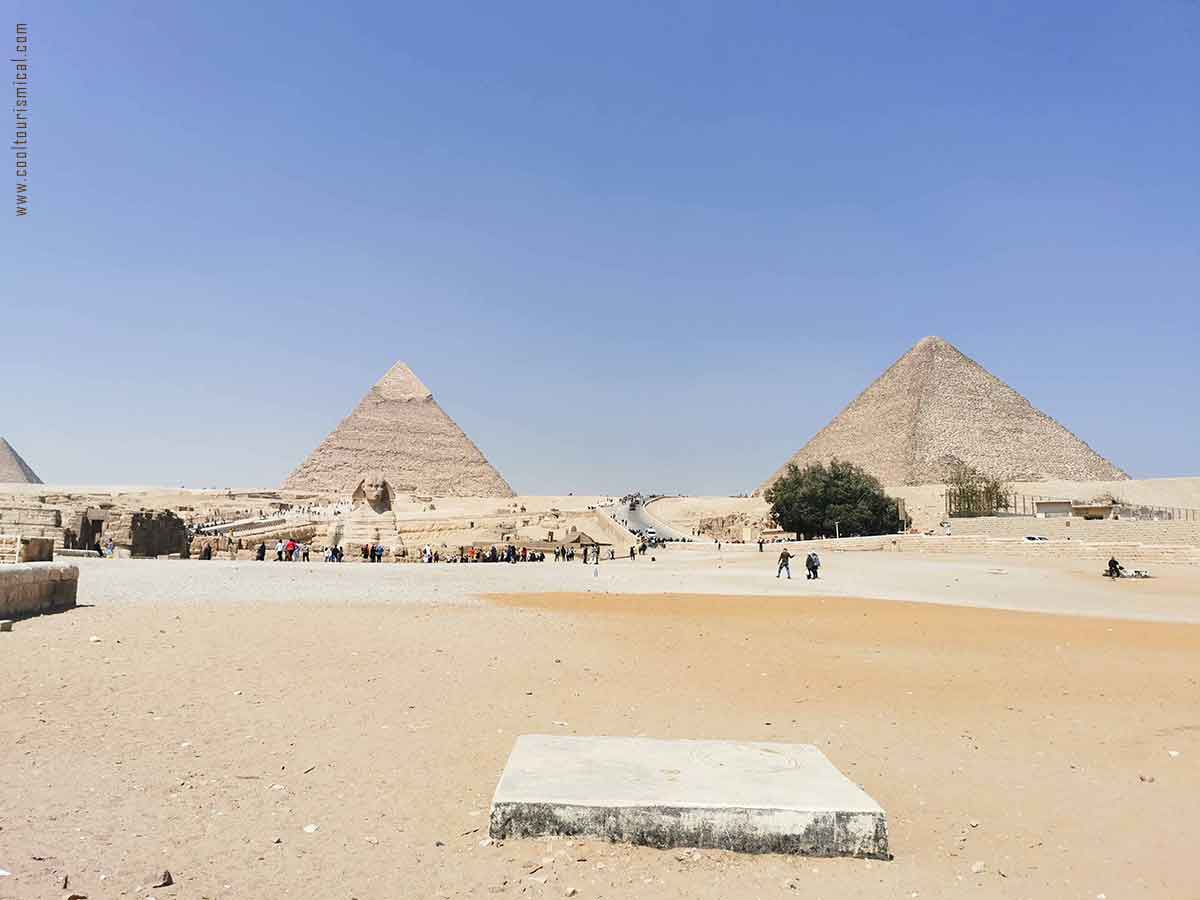
Giza Archaeological Site, Image Copyright © Cooltourismical.com
The layout of the ancient necropolis is rather compact, with the three main pyramids arranged diagonally, in descending size, on a northeast-southwest axis. Surrounding them are mortuary temples, smaller queens’ pyramids, causeways, and the Great Sphinx guarding the complex.
Every part of the archaeological site in Giza is centered around the idea of funerary ritual and cosmic alignment, particularly with the sun.
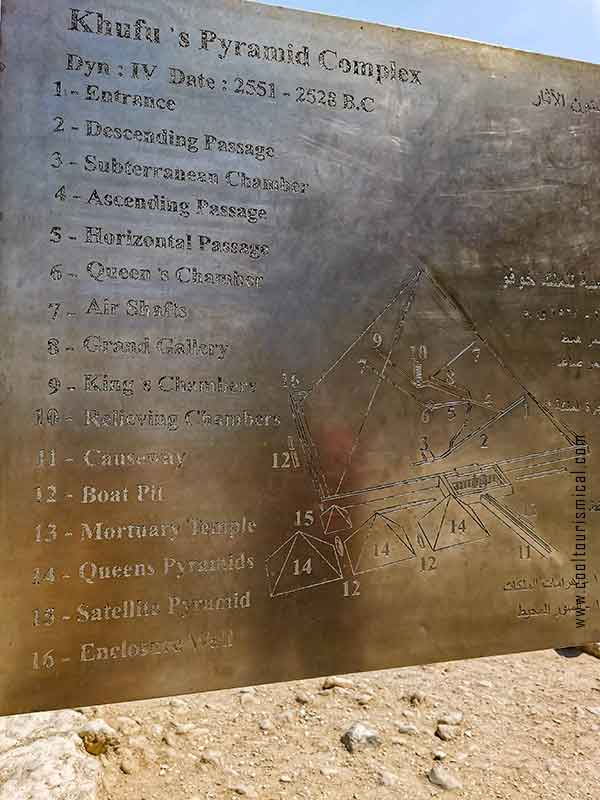
Khufu / Cheops Pyramid Complex in Giza, Image Copyright © Cooltourismical.com
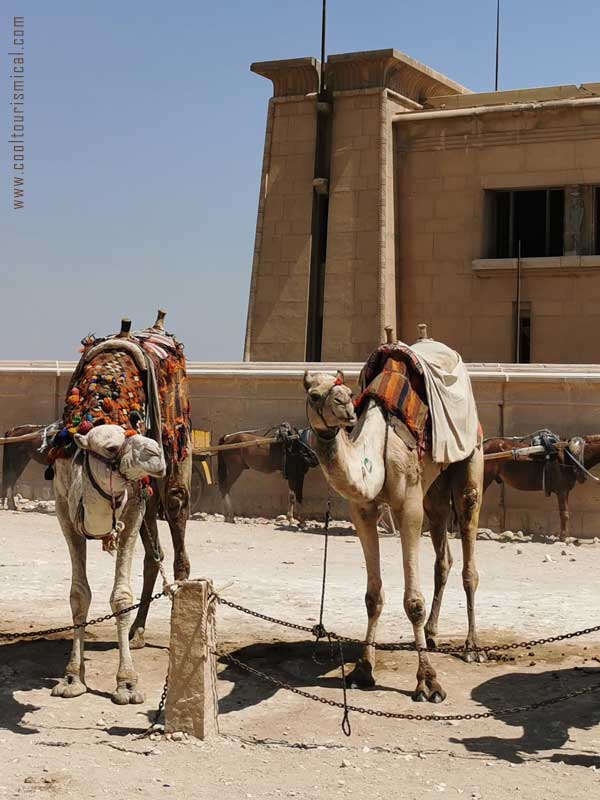
Cute Camels Camels at the Egyptian Pyramids in Giza, Image Copyright © Cooltourismical.com
Usually, the entrance is made through the main gate next to the Great Pyramid, and you can walk between all landmarks in just a few hours. The alternative way to move through the site are camel rides and horse carts.
And, the coolest thing about Giza is that you can also explore the inside of the pyramids, Pyramid of Khufu being open year-round, with a separate ticket: narrow, steep corridors are leading to burial chambers carved deep into the bedrock.
What you should consider is that you will spend a lot of time in the sun as the plateau is rocky and sun-drenched, with minimal shade and lots of open space.
📌 Recommended Visit Time: a regular visit including walking between pyramids, entering one pyramid, and seeing the Sphinx – 3-5 hours. Visiting the Eastern Cemetery, museums, riding ca horse cart etc. – 6-7 hours.
Teotihuacan
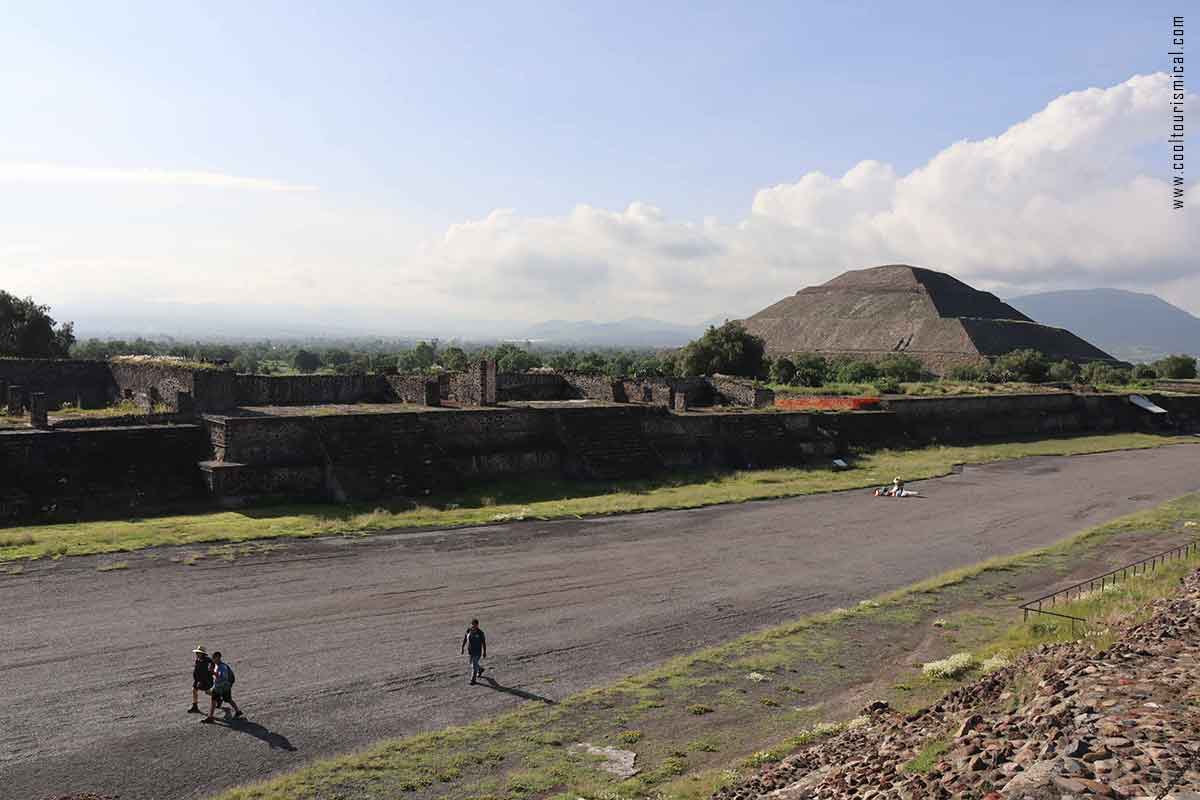
Pyramid of the Sun and Avenue of the Dead. To the left – Moon Pyramid, to the right, La Ciudadela, Image Copyright © Cooltourismical.com
Teotihuacan pyramids stand tall about 40 km (25 miles) northeast of Mexico City. You can get there by bus or taxi / Uber, which are all extremely affordable.
Inside, you just need to follow the main road and it will take you to most important landmarks. Each landmark has its own info panel with its own small area map.
If Giza is set at the edge of Sahara Desert, Teotihuacan has the privilege of lying in a less urbanized, green highland valley, with mountains in background, while wild nature is creeping into the ruins.
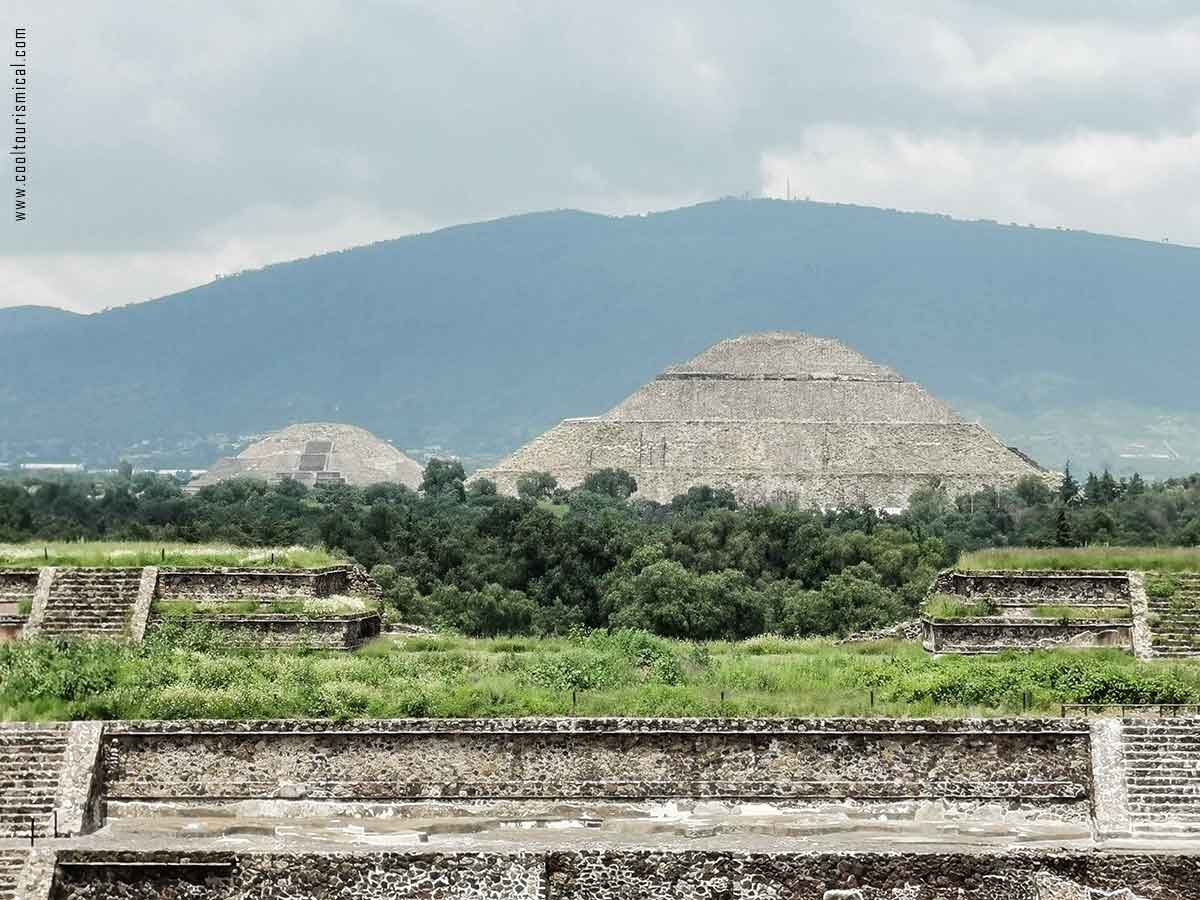
Pyramid of the Moon and Pyramid of the Sun, from nearby La Ciudadela, Image Copyright © Cooltourismical.com
As it used to be a metropolis, both for ceremonial and daily life, Teotihuacan has this vast, urban-grid layout, structured along a central, wide road, the Avenue of the Dead, that runs about 2 km, on a North-South axis, from Pyramid of the Moon to the Temple of the Feathered Serpent (Citadel).
Even so, you will have to climb a lot of stairs, on the road and outside it.
Along the way, you pass the towering Pyramid of the Sun, smaller platforms, temples, and what’s left of the residential compounds.
The entire site appears to reflect cosmological principles, possibly including solar cycles and the cardinal directions. But the whole experience feels more like walking through an ancient city than visiting a monument. Many people pair their visit with a hot air balloon ride at sunrise.
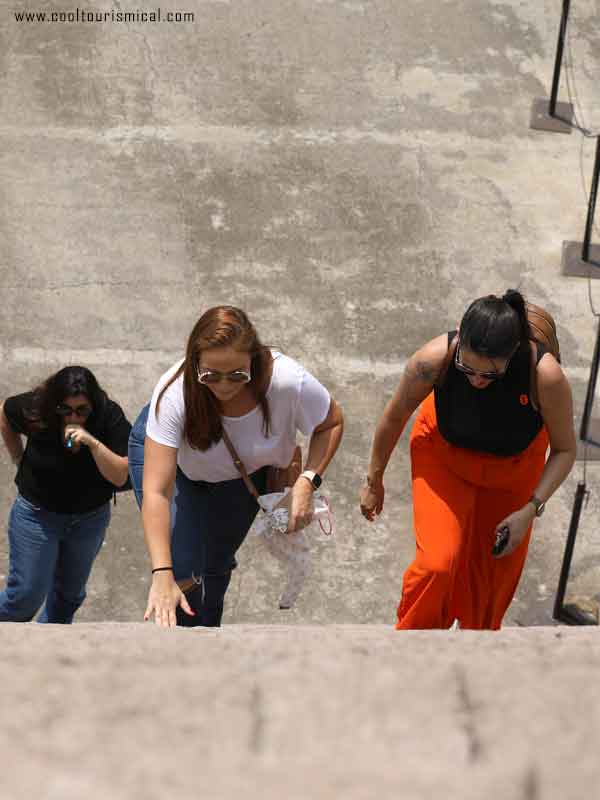
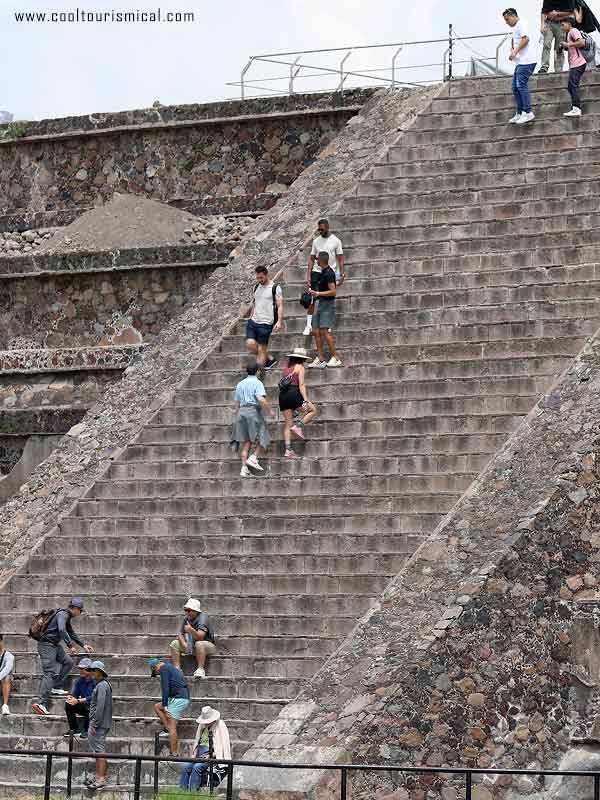
People climbing the platform inside La Ciudadela, Image Copyright © Cooltourismical.com
While you can’t enter the pyramids—they are solid inside—you could once climb them; today, climbing is mostly restricted, though you can still go up the exterior shell surrounding the Temple of the Feathered Serpent, the platform of La Ciudadela.
The complex is open and walkable, with wide plazas and shade under the pepper trees. But keep in mind: the sun is very strong due to high altitude.
📌 Recommended Visit Time: for a full visit including climbing, museums and walking along the Avenue of the Dead – 4–6 hours
 Extra Activities
Extra Activities
Just exploring for a whole day only the pyramids is incredible on its own, but there are also some other amazing activities or tours with locals that could make your day even more memorable, both in Giza and Teotihuacan.
These extras can also be a decisive factor in choosing your destination, things that one place has and the other doesn’t. Seeing the camels in Giza, for example, or riding a hot air balloon over Teotihuacan.
Here are a few experiences you might want to check out.
Giza
Teotihuacan
 Best Time to Visit Each
Best Time to Visit Each
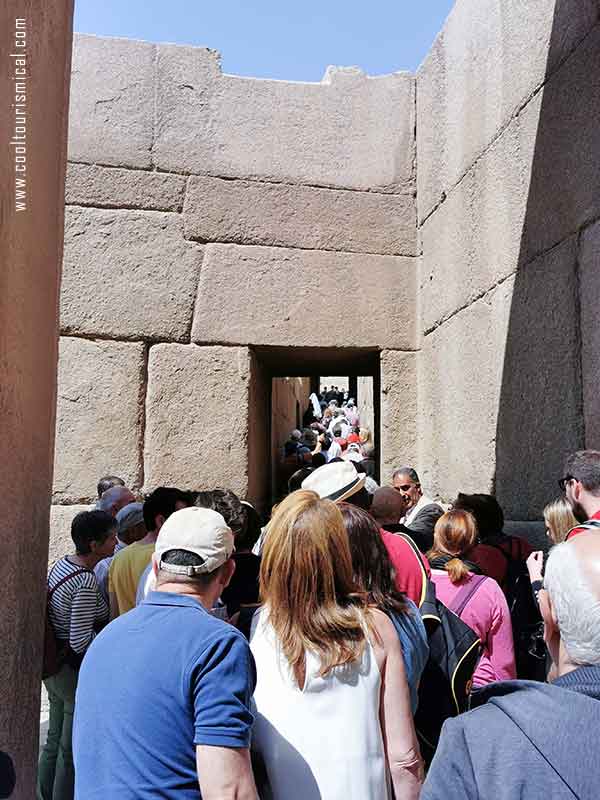
Giza in May, Image Copyright © Cooltourismical.com
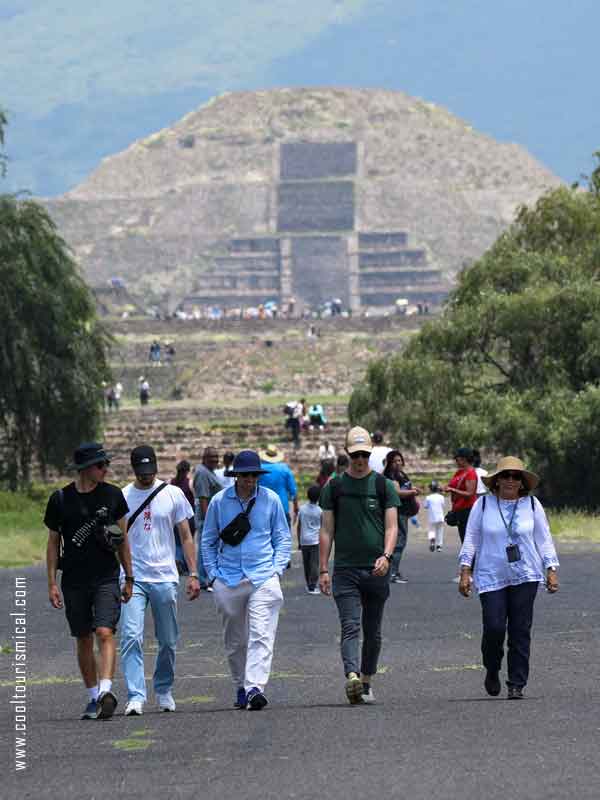
Teotihuacan in September, Image Copyright © Cooltourismical.com
Both archaeological sites are year-round pyramid destinations.
Still, if you’re choosing based on the weather, Giza’s heat has the potential to become unbearable in the summer, while Teotihuacan’s biggest challenge is definitely the rainy season.
📅 Best Time to Visit Giza
I visited Giza in January (not so crowded) and May (already a bit crowded, and loud). In January, I wore a sweater, a light cardigan, and a scarf, while in May I was in jeans and a very light sweater.
Both times felt perfect to me, although it’s generally recommended to visit Giza Pyramids between October and late April, as temperatures from mid-May to September can climb above 35°C (95°F). It did not happen to me. But if it does, then you can get really exhausted walking under the desert sun, especially since there are no places to shelter, except maybe inside the pyramid.
📌 Crowd peak times: December – February / winter holidays, April / Easter
📌 Best time to avoid crowds: Early mornings (opening hour) or midweek in October or March.
📅 Best Time to Visit Teotihuacan
On the other hand, Teotihuacan is said to be best enjoyed during Mexico’s dry season, from November to April (~22–27°C / 72–80°F). I personally visited in September and was lucky enough to get a clear sky for most of the day. The rain did start around 6 p.m., but I was already on the bus, heading back to my hotel in Roma Norte, in Mexico City.
The rainy season lasts from May to October, and these (not-so-occasional) afternoon showers can make paths slippery and harder to move around the site. However, November can be crowded because of the Day of the Dead, and December is the busiest month of all.
📌 Crowd peak times: December, Weekends (as it is a very popular local day trip from Mexico City), Public holidays, especially Day of the Dead (early November) and Semana Santa (Holy Week).
📌 Best time to avoid crowds: Weekdays, especially Tuesday–Thursday mornings in the dry season.
 Souvenirs
Souvenirs

Giza Souvenirs:
- 🐱 Bastet statues
- 🐞 Scarab beetles
- 🔺 Alabaster pyramids
- 🖋️ Cartouche necklaces
- 📜 Papyrus art
- 🧴 Perfume oils

Teotihuacan Souvenirs:
- 🗿 Obsidian figurines and masks
- 🐆 Jaguar whistles
- 🌞 Miniature pyramids
- 📿 Handcrafted jewelry
- 📜 Replica carvings of Aztec calendars
- 🧶 Handwoven textiles
Now, let’s talk about the lovely memories you can bring back home from the pyramids. My favorite part.
In Teotihuacan, you’ll generally find colorful folk art and obsidian crafts, while in Giza, shopping for souvenirs leans more toward a treasure hunt with symbolic relics and pharaonic keepsakes. But in both places, you’ll have to be ready to spot the fakes and bargain.

Souvenir Store in Giza, just outside the Pyramids Complex main entrance, Image Copyright © Cooltourismical.com
Around the Giza Plateau, vendors are literally everywhere, and as a tourist, you can expect haggling and pressure. This is how I felt and this is why I would recommend skipping the quick grabs and going for the quieter shops and papyrus galleries just outside the complex.
That’s where I got some beautiful postcards, books, and bookmarks. And while the shopkeeper was busy adding up the prices, he even offered me a cup of tea. It felt so sweet and calm after a whole half day walking in the sun and all that crazy buzz outside.
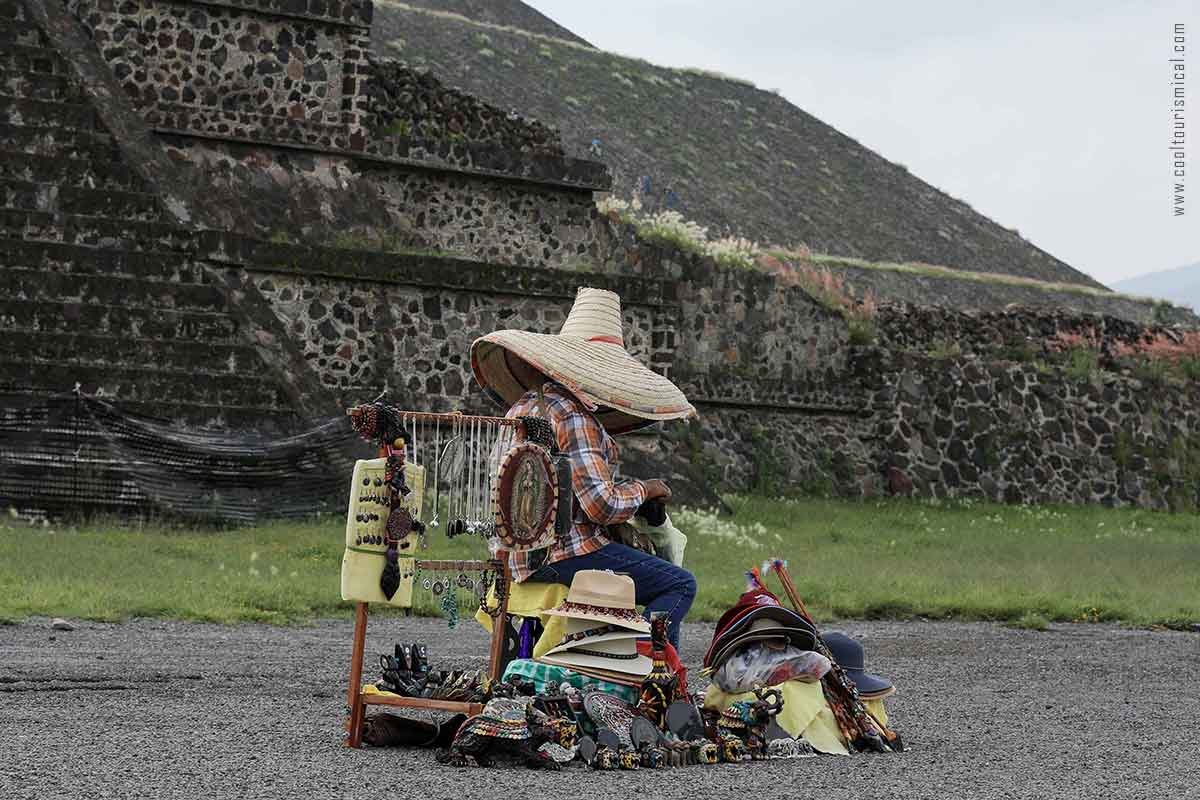
Souvenir Vendor at Teotihuacan Pyramids, Image Copyright © Cooltourismical.com
I found that, in contrast to Giza, souvenir shopping at Teotihuacan is definitely more relaxed. People are extremely kind, and some of the vendors will simply use jaguar whistles to catch your attention.
They usually set up blankets with different goods along the Avenue of the Dead, or have a small stand in the artisan market at the entrance. The Mexican style seems more artisanal, compared to the “hard-sell” approach at the Egyptian pyramids.
 Cost & Travel Considerations
Cost & Travel Considerations
💱 Costs & Local Currency
I tried to get into details as much as I could, but obviously, it will al depend on your budget.
It is important to bring local currency — Egyptian Pounds (EGP) for Giza, Mexican Pesos (MXN) for Teotihuacan. In Giza, sometimes they accept getting paid in smaller, pretty unknown currencies like Romanian Lei, which will not happen in Teotihuacan.
Factor
🧭 Giza Plateau
📐 Teotihuacan Pyramids – Mexico
Entry tickets
~$14
~$6
Pyramid Entry
$19 (Cheops interior)
Included
Transportation
Uber/taxi roundtrip = $25
Bus roundtrip ($6), Uber roundtrip = $35
Guide (optional) / person
$20–$50 (avg. $30)
$15–$30 (avg. $20)
Food / Snacks
Around $7
Around $10
Souvenirs
Mini pyramid (stone or alabaster) $2 – $5; Papyrus scroll with hieroglyphics $5 – $10 (avg. $20)
Obsidian figurine (eagle, mask, pyramid) $5 – $15, Aztec calendar plate (mini or medallion) $5 – $12 (avg. $20)
Extras
Camel ride = $10 / 2 hours
Balloon ride (adults only): $120-$150
Total for a day at the pyramids / person
$150
$122
Hotel / night
Prices from $35 (3⭐) to $250 (5⭐)
Prices around $60 (3⭐), $90 (4⭐) to $350 (glamping 3⭐)
🏨 Where to Stay Nearby
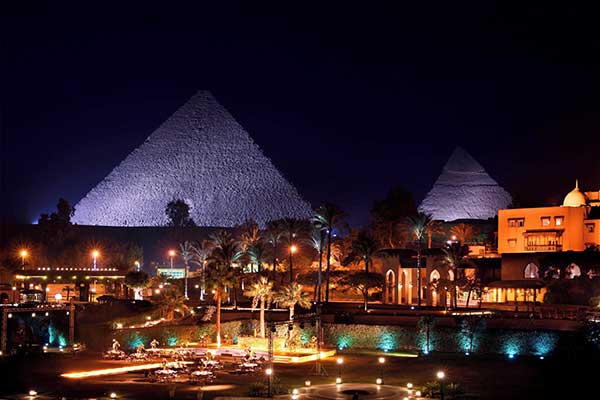
For Giza, look for hotels with pyramid views or stay in central Cairo and take a taxi.
The closest hotels to the pyramids is Marriott Mena House, Cairo ⭐⭐⭐⭐⭐, which is historical and luxurious.
But there are also more affordable ones, and really well rated also, like Pyramids View Inn B&B ⭐⭐⭐ – right across the street from the Sphinx entrance, rooftop views of the Sphinx and pyramids.
I preferred, at that time, to find some accommodation in Cairo.
I stayed at a place called Maran Residence in New Cairo, more of a medium-priced boutique hotel, elegant and cosy, but pretty far from everything.
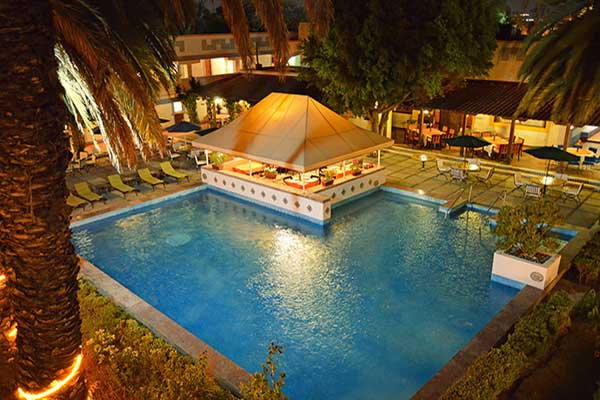
For visiting Teotihuacan site, you can stay in San Juan Teotihuacán, quite close to the pyramids.
But I preferred to return to Mexico City. If you do that, you can choose one of the hotels in Roma Norte, Polanco or Centro Histórico districts.
If you plan to stay in Teotihuacan, Villas Arqueologicas Teotihuacan ⭐⭐⭐⭐ is a really beautiful place, just a 10-minute walk from the main gate. Plus, I would also mention Hotel Quinto Sol ⭐⭐⭐⭐, which is a bit further away, but still cozy and colorful. Distance: about 5-minute drive to the archaeological zone.
Both are peaceful retreats with that unique traditional Mexican feel.
💸 Which Destination is Cheaper? Giza or Teotihuacan?
Considering all the above, and obviously without taking into consideration airplane tickets, Teotihuacan is, in my opinion, the more affordable pyramid destination.
Entry tickets are cheaper in Teotihuacan, and guides and local transportation also cost less overall, and souvenirs are usually more budget-friendly. There are more transportation options, compared to Giza, from public buses to organized tours and ride-sharing apps like Uber, even for the Teotihuacan route.
In contrast, Giza involves more add-ons: separate fees for entering the pyramids, the Solar Boat Museum, camel rides, and tipping, which is generally expected. Balloon rides are the only major optional splurge in Teotihuacan.
Local accommodations are similarly priced, often with higher prices in Giza, but it seems that you’ll often get more in terms of comfort for your money in Mexico. Even so, nothing quite compares to the breathtaking pyramid views from the hotels surrounding Giza, an experience that’s hard to match.
 So, Which One Should You Visit First?
So, Which One Should You Visit First?
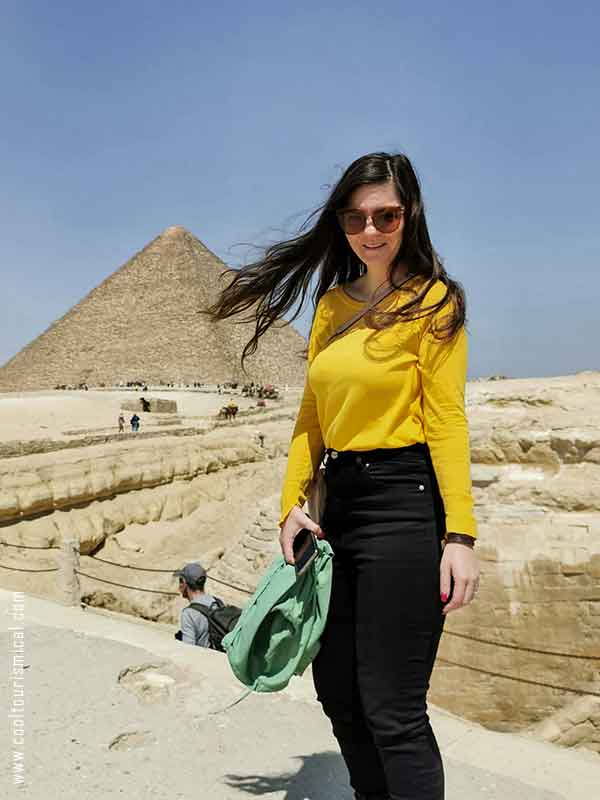
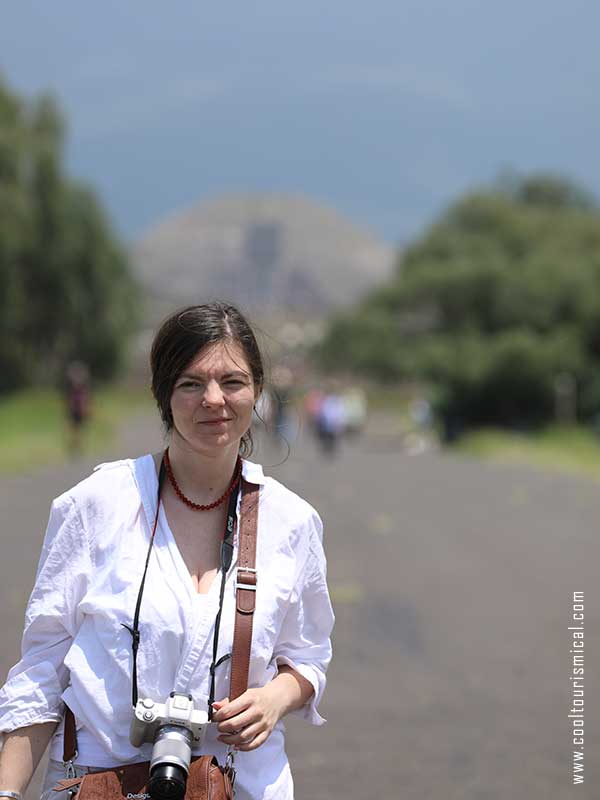
Me visiting Egyptian Pyramids (left, with the The Great Pyramid of Giza in the back) and Teotihuacan (right, with pyramid of the Moon in the background), Images Copyright © Cooltourismical.com
For me, both the Giza and Teotihuacan pyramids are hard to forget. After all, these are two of the world’s most dreamed of and searched for pyramid destinations, each spreading an infinite dust of ancient magic.
Giza is more suited for those who crave pure fascination and a lasting impact. The sheer scale of the pyramids, the mystical association to pharaohs and gods, and the entire symbolism surrounding them make the experience quite overwhelming.
I would totally recommend starting here if you have always wanted to visit one of the last ancient wonders that’s still standing. From every angle, it’s as dramatic, as it is intense.
Teotihuacan pyramids, on the other hand, invite you to wander, wonder, and meditate. It’s more about mystery than monumentality, more about rhythm and order than grandeur.
Start here if you’d love to explore an old, deserted city, discover carvings hidden in stone, and feel connected to a world once filled with music, markets, and ceremonies – America’s once biggest metropolis.
Where to go first:
- 📌 If you want epic scale and a lost world wonder, go to Giza pyramids.
- 📌 If you want spirituality, color, and calm, start with Teotihuacan ones. Read more on how to visit Teotihuacan Pyramids.
 Giza & Teotihuacan at a Glance
Giza & Teotihuacan at a Glance
–
🧭 Giza Plateau
📐 Teotihuacan Pyramids – Mexico
Civilization
Old Kingdom, 4th Dynasty (c. 2600–2500 BCE)
Pre-Aztec Civilization (c. 100 BCE – 550 CE)
Function
Royal funerary complex
Ancient metropolis
Main Structures
3 Pyramids, Sphinx, mortuary temples
Pyramid of the Sun, Moon, Temple of the Feathered Serpent
Pyramid Type
Smooth-sided, geometric “true” pyramids made of limestone and granite
Stepped pyramids, talud-tablero style, from Volcanic rock (tezontle), with stucco and mural paint
Cosmic Alignment
Aligned to cardinal directions (N-S-E-W), Orion’s Belt, Sirius, shafts to northern stars.
Aligned ~15.5° east of north; matches zenith sun and solar calendar, alignments to Pleiades, Venus, Milky Way
Visit Time
3–5 hrs (basic)
4–6 hrs
Extras
Camel rides, papyrus museums
Balloon flights, temazscal ceremonies, safari
When to Visit
$150
November to April
Hotel / night
October to April
Prices around $60 (3⭐), $90 (4⭐) to $350 (glamping 3⭐)
Visiting Budget
approx. $150
approx. $120
 FAQ
FAQ
🏨 Which pyramids are bigger?
The Pyramids of Giza are nearly twice as tall as those at Teotihuacan.
Just to get the idea, the Great Pyramid of Khufu (Cheops) stands today at 137 meters (449.5 feet), while the Pyramid of the Sun reaches only about 65–70 meters (213–230 feet) in height.
Interestingly, their base dimensions are quite similar: Khufu’s pyramid has a base length of 230.4 meters (755.9 feet) per side, compared to 225 meters (738 feet) for the Pyramid of the Sun.
🏨 Can I climb the pyramids?
Mmm… No. Climbing the outside of the pyramids in Giza is quite illegal and can get you arrested, fined, or even jailed. even touching them can get you a warning. Someone will usually show up to tell you not to lay your hands on them.
It used to be allowed though at Teotihuacan, but not anymore. These days, you’re only allowed to climb the platforms in front of the pyramids, and not the pyramids themselves.
🏨 What are the similarities between Teotihuacan and Giza?
Both feature massive pyramids built with advanced engineering, aligned to celestial events, and central to their civilization’s religious and cultural life.
Got questions about visiting either site, or still can’t decide which one’s for you? Drop them in the comments and I’ll be happy to help you plan your perfect pyramid adventure! Until next time!


